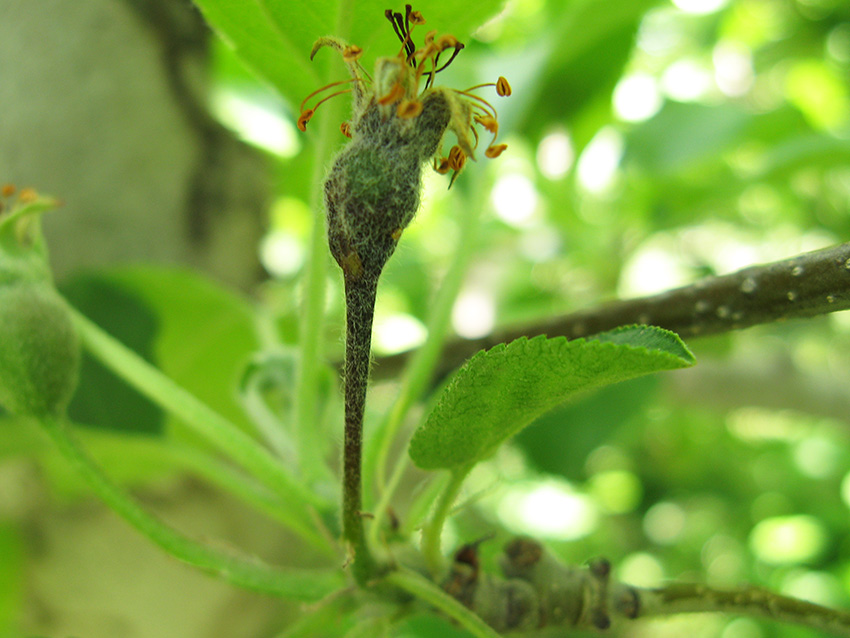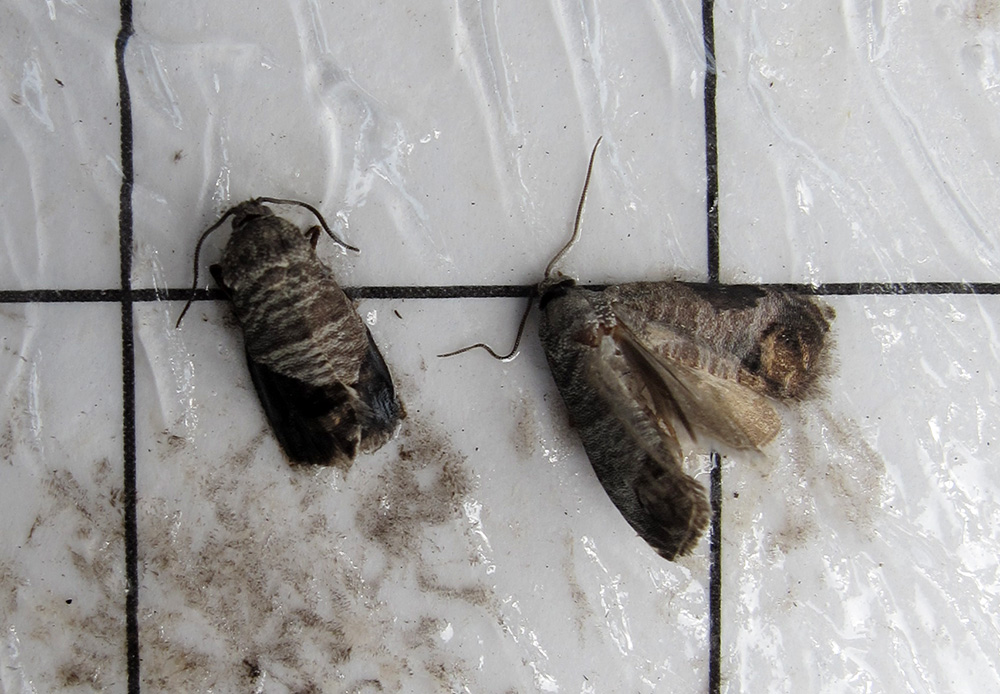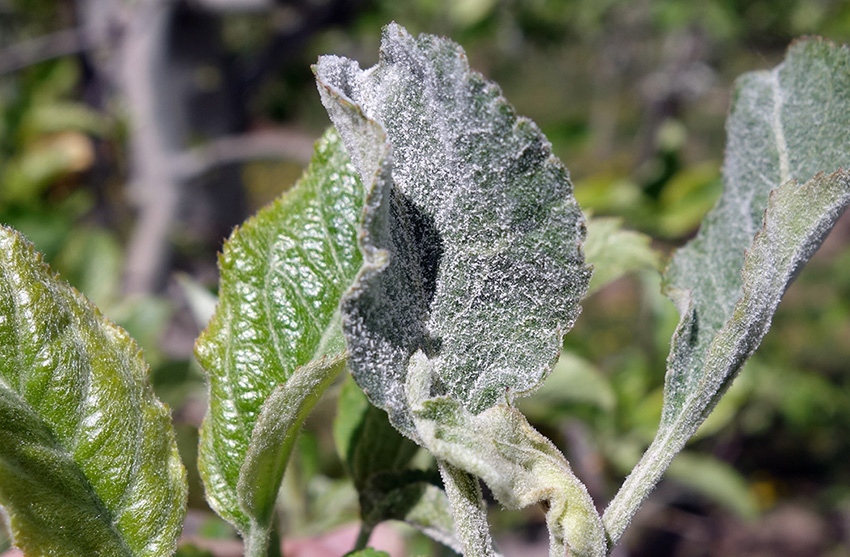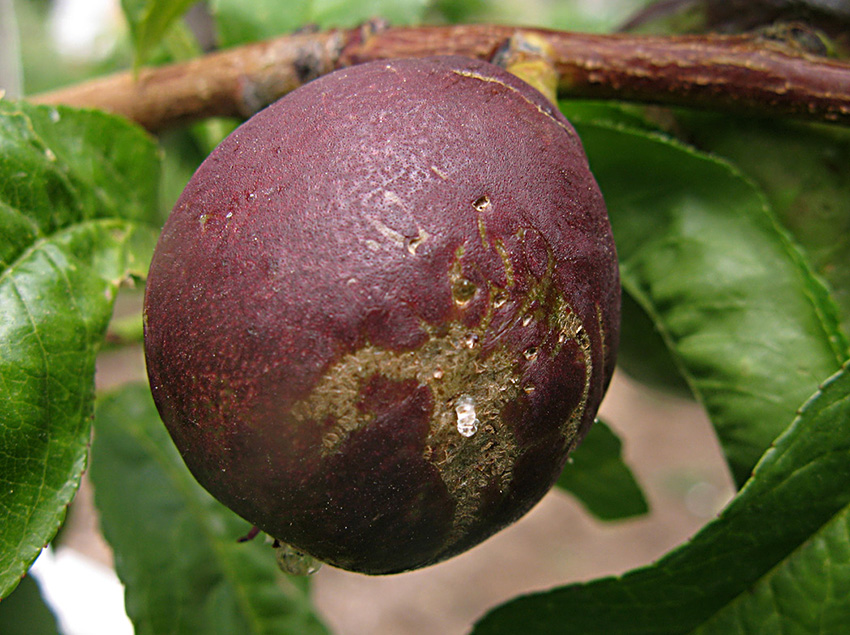In this Issue:
- Apple, Pear: fire blight, codling moth for SOME Utah locations, powdery mildew
- Apricot, Peach/Nectarine: fruit scaring caused by western flower thrips
APPLE, PEAR
Fire Blight
Risk is extreme through Friday, April 26; infections may happen on OPEN blossoms in warm, wet weather

Fire blight is a bacterial plant disease that causes infections through open flowers, so whether you take action depends on if your trees are blooming. Rain is predicted this week for much of northern Utah, which means an excellent chance for infection.
Where fire blight has been a problem in past years, it is better to be safe and protect the blossoms of young trees especially.
There is an EXTREME risk of infection for all areas of Utah through April 26/27. With the upcoming rain forecast, we recommend a treatment (if there are open blossoms), on Wednesday, April 24 (or the day before the rain).
The infection risk drops to “CAUTION” and “LOW” in northern Utah on April 27 and 28.
You can watch fire blight predictions on Utah TRAPs by selecting a location closest to you, and then selecting “fire blight” under the Pest drop-down menu.
Treatment
- For commercial producers, most areas (except the southern part of Utah County, which has resistance) can use streptomycin (if open flowers). Where resistance occurs, producers should use oxytetracycline (MycoShield) and/or Kasumin. Or, one application can be a mix of full-rate oxytetracycline and streptomycin.
- USU research found good success with using Blossom Protect as a first application, followed by an antibiotic (at full bloom), and followed by Serenade toward the end of bloom.
- Most diligent backyard growers should not need to apply an antibiotic. (Although if necessary, most garden centers carry streptomycin. Apply it on Wednesday, April 24 if flowers are open.) Instead, monitor trees closely starting two weeks after full bloom (which is when infections start to become visible). Prune out new infections immediately (on a dry day).
Codling Moth for SOME Utah areas
No action to take now in most locations

Information on spray dates for northern Utah will be delivered May 2.
To determine codling moth spray dates, we hang monitoring traps in Utah orchards. Once those traps catch moths, we can then run the calculations to determine the dates. We expect to see moths in traps in many areas in the next few days.
For the below Utah locations, the dates to apply your first spray of the season are shown.
- Capitol Reef – May 12
- Castle Valley: May 4
- Farmington: May 18
- Hurricane: April 23
- Kanab area: May 11
- Leeds: April 25
- Moab: May 7
- Salt Lake City airport area: May 17
- St. George: April 23
Treatment
Commercial: Growers should have mating disruption ready to hang in the next few days, as moth flight is approaching.
Backyard: The table below provides some options for backyard trees. This table is not all-inclusive, but just provides some examples. The products listed are not an endorsement. For the product you decide to use, the “active ingredients” are listed in small print on the lower right or left of the front label. Sometimes there are several ingredients, sometimes, just one. Some materials last longer than others, and the time between sprays is not always listed on the label.
| Product Name | Efficacy | Residual Length (days) | Comments |
|---|---|---|---|
| CONVENTIONAL | |||
| Spectracide Triazicide (gamma-cyhalothrin) | Good to Excellent | 14-17 | wait 21 days to harvest |
| Monterey Bug Buster 11 (esfenvalerate) | Good to Excellent | 14-17 | wait 21 days to harvest |
| Bonide Fruit Tree & Plant Guard (lambda-cyhalothrin) | Good to Excellent | 14-17 | wait 21 days to harvest |
| Bonide Malathion; Hi Yield Malathion | Good | 5-7 | max 2 applications; some products are pears only |
| GardenTech Sevin (zeta-cypermethrin) | Good to Excellent | 14-17 | wait 14 days to harvest |
| ORGANIC | |||
| AzaSol, EcoGarden (azadirachtin) | Good | 7-10 | purchase online |
| Cyd-X (codling moth virus) | Good (if populations are low) | 7 | works best when used at beginning of generation; expensive and purchase online |
| oil such as All Seasons Oil, EcoSmart, Neem oil | Good on eggs only | 3 | recommended for first application of the generation only |
| Ortho Fruit Spray; Fertilome Fruit Tree Spray; Safer End All; Bonide Orchard Spray (all contain pyrethrin) | Good | 3-5 | |
| Monterey / Fertilome Spinosad; Captain Jack's Deadbug Brew; Natural Guard (all contain spinosad) | Good | 10 | max 6 applications per season; if applying to peach or cherry, can re-apply after 7 days |
Apple Powdery Mildew
Apply fungicide at petal fall

The fungus that causes apple powdery mildew overwinters on twigs, and as a result, new infections can occur early in the season. Depending on weather conditions, it can become active at about the tight cluster to open cluster (pink) stage.
If your apples had powdery mildew in the past, treat after bloom (petal fall) if you have not already treated. A second treatment 2 weeks later may be required where powdery mildew has been severe in the past.
Commercial growers should be aware that in other parts of the country, powdery mildew fungal populations are becoming increasingly resistant to the Group 3 fungicides (Indar, Procure, Rally, Rhyme). These fungicides have curative effects and are mostly used after mildew has shown up. By using a product from a different fungicide group at petal fall, use of Group 3 products can be reduced, preventing resistance from occurring in Utah.
Powdery mildew spreads with high humidity, usually in the dawn or dusk hours, and does not need free water to germinate. When terminal shoots harden off and when relative humidity decreases, new infections slow down.
Some varieties are more susceptible than others (such as Braeburn, Gala, Gingergold, Jonagold, Jonathon, Rome). The Delicious varieties are the least susceptible.
Treatment
Commercial: Options with good to excellent efficacy that are not Group 3 products include Flint, Merivon, Sovran, Fontelis, and sulfur (organic). Click here for more.
Backyard: Spectracide Immunox, Monterey Fungi-Max, Hi Yield Wettable Sulfur (or other sulfur brands; organic), Monterey Complete Disease Control (organic)
PEACH/NECTARINE, APRICOT, PLUM
Prevent Scarring of Nectarine and Plum Fruit
Spray right after bloom is over (petal fall), using spinosad

If your nectarine or plum fruits were deformed last year, western flower thrips was the likely cause. It is a tiny insect that feeds on the developing fruit from bloom time to petal-fall.
Spinosad is the recommended material to treat for this pest. It is an organic insecticide made from metabolites produced from soil-dwelling bacteria. It is available in most garden centers and farm supply stores.
Spray at night or early morning because spinosad is harmful to bees when the product is wet (the dry product does not affect bees). Just a single application, with thorough coverage, is needed.
Treatment
Commercial: Entrust (OMRI organic), Success
Backyard: Monterey Garden Insect Spray, Natural Guard Spinosad, Bonide Captain Jack’s, and more
